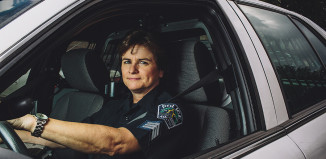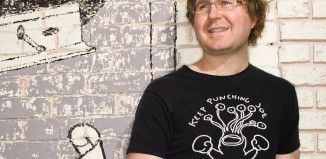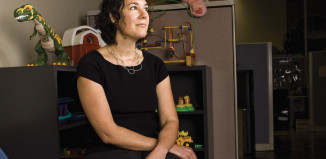“I always wanted to be an artist. I could always draw and make art,” said Reji Thomas, who has thrived as a painter, glassworker and artistic community advocate for 30 years. “I just didn’t know I could make money doing it.”
Thomas believes that any successful society is judged by two factors in the course of history: its humanity, meaning how were the most helpless treated, and its arts–did great art get produced? In her years of experience in the industry, and working to mentor younger artists, she’s always taken aback by the juxtaposition of art and how to treat it like a viable business. “People ask me, how should I price this? I say, what’s your cost of business? We should teach high school students about money and business.”
Even for Thomas, the learning curve of becoming an artist was significant. Thinking about what she’d always loved doing as a full-fledged career wasn’t easy. At the age of 15, in the only art class she ever took, Thomas sold her first painting for $250.
Her grandmother, who had only a fourth-grade education but was a property owner and the stabilizing force for everyone in Thomas’ extended family, was generous in providing shelter for cousins and nephews and drove her pickup truck into town to buy supplies as needed. That compassion runs in the family. “Now, it irritates my friends that I will take people in and help them out,” Thomas said. “That’s what we’re supposed to do. It takes half a paycheck to be that person, on the couch.”
Chickens, Eggs & Gays-Oh My!
Thomas, born a few months premature in a Los Angeles hospital to a mom who was a registered nurse and a dad who was an electrical engineer, was sent on a train with her aunt to live with her grandparents on their family’s expansive farmland property in Evergreen, Alabama. This was the deep South, at a time when black people who rode the train had to get out and drive when it arrived in New Orleans.
Their living arrangements, out in the woods with no indoor plumbing, were nontraditional. Her grandparents had several hundred acres of land, complete with well water, a tractor, a wood-burning stove, mules and a garden. “I didn’t know we were poor,” she said, noting that she would gather wood or feed the chickens and help out in the garden. “I also didn’t know that we were living organic, I thought we were being tortured.”
Shuttling back and forth between her parents on the West Coast and her extended family in Evergreen had its benefits, too. Early on, Thomas was exposed to a wide range of life-styles and developed an appreciation for the gay and lesbian community. Her mother entrusted the care of her children to two gay men, brothers by the names of Ronnie and Don- nie. “They were really clean, prestigious, gossipy and fun,” Thomas said, adding that the brothers maintained a relationship with her family for three generations.
She attended 16 different schools before graduating high school. Thomas’ first completed drawing was a pencil drawing of her great-grandmother, whom she would spend Sundays with to avoid attending church.
Business Education
As a young artist growing up, Thomas didn’t have many mentors–well-known people of color who worked as artisans–so she didn’t fully pursue her talents immediately. “I was taught that art just wasn’t that important,” she said. “There were singers, boxers, musicians, but whoever heard of a black artist?”
Having no fear of blood (“I’ve sutured myself up, and friends, no problem.”), she worked as a medic in the U.S. Air Force for about four years. Upon graduation from nursing school, Lackland Air Force Base in San Antonio was her first stop. The number one song on the charts was Stevie Wonder’s “Very Superstitious.”
Even so, she persisted, utilizing tools from the dental clinic where she’d worked to etch glass while in the military. For her last duty station, she chose Austin because at the time, she was driving a car called an Austin American. The Capital City’s unique characteristics, with multiple universities, endless green space and the beauty of the Colorado River system, impressed her. At that point, the city’s population was a fraction of today’s and the Pearl Street Warehouse was one of the main gay bars.
Becoming a DJ at local gay bars such as Pearl Street Warehouse and Hollywood was her first business venture. In between stints spinning records, she also worked as a successful salesperson at Yaring Shoes, selling high-end pumps to the ladies who could afford them. With every job, the human connection was something that Thomas mastered. She instinctively sensed what people wanted, whether it was which music to play to get club goers moving or what customers needed to hear about the shoes they tried on.
“I was still etching glass throughout this time,” she added. “People would hire me to do windows or doors for them. I took my dining room, turned it into an art studio and drove all of my roommates crazy.”
Her persistence paid of. Thomas became an in-demand glasswork artist, able to work confidently with double acid-etched glass (a feat that few accomplish), including a commission to produce 500 panels for the Texas State Capitol’s renovation. She traced her early interest in glass etching to her mother, who collected a variety of exquisite plates and cups. “When you got to the bottom of the cup, you looked through and there was a photograph at the bottom,” said Thomas, noting that she rarely got to drink out of these cups. “I couldn’t figure out how the photograph got there. It drove me nuts when I would clean them. I was trying to reproduce what I saw.”
Community Space
Back in 1979, Thomas had recurring dreams about trains. One day she was exploring Austin, which, according to her, was like being inside an old antique store at that point, and she turned down East Fifth Street, finding herself amidst a few old buildings tucked near railroad tracks by Waller Street.
“I had insane deja vu, and I felt like I’d been dreaming about this building,” Thomas said. “I went and opened up this door. It was empty, the roof was barely a roof, sunlight was streaming in and it smelled like motor oil.”
After asking if she could rent part of the space, and receiving the go-ahead, she installed lights and bathrooms and moved in shortly thereafter. Early on, she spent a few cold winters in the building, which is at least 150 years old.
About three years later, she purchased the entire old railroad building, known as Pine Street Station, outright. Now filled with her own imaginative, colorful paintings and ongoing large-scale glasswork projects, as well as the work of other artists, the space oozes the kind of eclectic artistic energy that permeates Austin. Inside, the walls and floors are all longleaf pine, and several of the spaces are adjustable in terms of creating smaller artist studios or opening it up to host events such as last year’s Art Erotica.
Beyond utilizing Pine Street Station as a plaace for art shows or nonprofit events and a rehearsal space for performers, Thomas is launching a weekend artists’ market in April, bringing together student and professional artists for demonstrations, miniclasses and more. In 20 years, she expects the space to be part of a historic arts district and a focal point for visual artists of all types, drawing in musicians as well, for the entire city.
Thomas is also producing a book, a compilation of her paintings and glasswork, and preparing for a big show at the Pasadena Museum of California Art.
“I was born to be an artist,” she said, without hesitation.



































